| Therapy comes in many varieties, however the one that we are interested in is 'sound therapy'.
Sound therapy can do lots of things. For example it can restore certain frequencies in the ear, help to overcome learning difficulties, reduce anxiety and improve concentration. These are just a few of the potential things that this kind of therapy can do. | "Sound therapy can [...] help to overcome learning difficulties, reduce anxiety and improve concentration." | We became interested in this through looking at having speakers within the prosthesis to enhance or alter our sense of hearing. Alternatively it can change the sense of atmosphere too. This research has also led to 'infrasound', which is also something which we will explore. It has the potential to alter the mood of a person without the person having any realisation of why it is happening. This may very well fit into our project and ideas very well.
We started to think about ideas for implementing aerogel with our concept ideas. 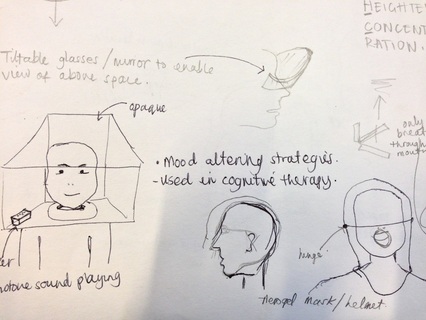 To the right is a picture of some of the ideas we had for designing a prototype. We had ideas ranging from encasing the head within a large box to wrapping it tightly against the skin.
We toyed with ideas of having speakers in the prosthesis to emit sound to the wearer as well. This could be used to enhance the user's perception of sound, or even to use sound to change the mood. The sounds can be used to create a specific atmosphere within the prosthesis for the wearer.
We also thought about different ways to put the prosthesis on and take it off. For example, it can be hinged to allow access in a similar way to a visor. Alternatively it can have straps which attach around the back of the head, crossing over to secure the prosthesis in place.
The image below shows the idea which came out on top from our initial ideas. It is a helmet which fits to the face, but not tight to it. It has enough space around it that the user is not in full contact with it, it sits comfortably around the head approximately 15mm from the skin. It is constructed from aerogel and is hinged at the top to allow it to open, almost like a clamshell. We decided that there should be rubber or foam around the edges so that it is comfortable on the places of the body that the helmet does touch. It should go no lower than the chin, so as to allow for full movement of the head without the helmet touching the neck. The helmet should also have ergonomically moulded places on the sides for ease of removal. There will also be space cut out around the mouth to enable the user to breathe. | The image below shows the idea which came out on top from our initial ideas. It is a helmet which fits to the face, but not tight to it. It has enough space around it that the user is not in full contact with it, it sits comfortably around the head approximately 15mm from the skin. It is constructed from aerogel and is hinged at the top to allow it to open, almost like a clamshell. We decided that there should be rubber or foam around the edges so that it is comfortable on the places of the body that the helmet does touch. It should go no lower than the chin, so as to allow for full movement of the head without the
helmet touching the neck. The helmet should also have ergonomically moulded places on the sides for ease of removal. There should also be space cut out around the mouth to enable the user to breathe. | "There should also be space cut out around the mouth to enable the user to breathe." |
| Aerogel was developed by NASA for use in space collecting stardust. But more recently it has become far more publicly available.
Its properties are continually outstanding. For example, it is 99.8% air and insulates 39 times better than the best of fibreglass insulation. It is also "[...] 1,000 times less dense than glass." It is based on silicon and is spongy in consistency. It is remarkably light and has amazing tolerance against heat. It is also very structurally strong. | "People on the outside would resemble ghostly figures." | | These properties make it perfect for our current idea of encasing the face. The low weight would allow for continued wearing in comfort. The insulating properties would block off sound from the outside and the smoke-like appearance would mask the outside world in a frosted glass effect. People on the outside of the mask would resemble ghostly figures. The effect would be more than an isolation of the touch sense. It would cause emotions, fear and fright. In turn this would cause adrenaline to be released, causing an increase in heart rate and breathing rate. The experience of walking through the caves would become an entirely amplified experience. There would be more than just claustrophobia, there would be a near complete cut off from the outside world. An interesting, if not frightening thought.
What if we could isolate everything and leave only touch? No sight, no sound, no smell, no taste, no temperature. Just touch... Following on from the idea of sensory deprivation inspired by the Horizon documentary, we have started exploring the concept of it being used for our prosthesis.
We watched a video from the BBC called 'Horizon: Is Seeing Believing?' This fascinating documentary provided an insight into how our senses work, and how one sense can be enhanced through the loss of another. | There were some amazing explanation of how our senses work, using examples such as the McGurk effect to show that what we hear isn't solely reliant on our ears. The way that we interpretate speech also relies on what we see too. But perhaps most interesting was the idea that depriving some senses could enhance others. There was example of a cyclist in the video who had no sight. They were completely blind, yet fully capable of navigating unaided on their own, even at the speeds provided by a bike. This was done in much the same way as a bat navigates, using clicks and echoes - this is called 'echo locating'. This idea of enhancing senses via isolation is an interesting one, and a concept that we as a group feel compelled to investigate. | "They were completely blind, yet fully capable of navigating unaided..." |
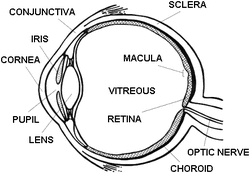 If we choose to work with sight, it only seems sensible to research the part of the body which is responsible for it. The diagram to the right is of the human eye. It is a complex part of the body and the way that it works is very clever. Light enters through the pupil, the dark dot in the middle in the middle of the eye. How much light is let through gets determined by the pupil, which is controlled by the iris. The iris causes the pupil to contract or dilate depending on the intensity of the light. Intense light will cause the pupil to contract, and vice versa.
Light is directed through the pupil by the cornea. It is then focused using the lens and aimed towards retina at the back of the eye. The lens sharpens the image for the centre of the retina as this is where the most cone cells are located. This is where get even smarter. The retina consists of two types of cells; cone cells and rod cells. The cone cells are densely packed into the centre of the retina and cause the high resolution colourful image that our sense of sight provides during bright daylight. They pick up on the things that we are directly looking at. The rod cells are slightly different. They sit around the outer areas of the retina and catch hold of light that lands further away from the centre. This is what causes our peripheral vision. They are lower resolution, but better at picking up light. Hence they are most useful during the dark, when our pupils dilate and allow more light to hit the outer areas of the retina, the rod cells. They also responsible for detecting movement too, and help us with our coordination.
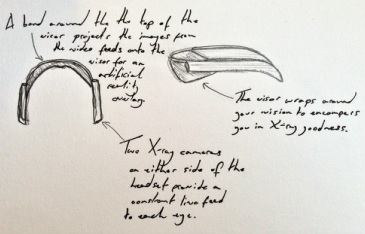 The reason we can't see X-rays naturally is because the cells on the retina aren't tuned in to see them. They are only capable of picking up on the visible light spectrum, ie the colours we see around us. The cells then convert the light into electrical signals which get sent to the brain to be interpreted. But what if we could visualise the X-ray spectrum in a way that our brains could understand? We do it in hosptials using cameras to show us still pictures, but if we could create a live X-ray video feed then we could see whatever we looked at in glorious X-ray vision!!
The caves that we were able to explore in Ye Olde Trip To Jerusalem were only a few of several hundred that have been found under the surface of Nottingham. There are more than 450 known artificial caves. One thing that became clear was that we all wanted to see more of them, even all of them at once. The solution was simple, we needed X-ray goggles...
| | To the left is a map of the Nottingham tunnels generated by 'Nottingham Caves Survey'. The cave system is huge and to be able to see them all at once would be incredible. You could walk around above the surface and see what caves are below you, even if they are inaccessible. X-ray goggles could even allow the discovery of new caves altogether. They would definitely enhance your sight in this way and could provide a whole new way to experience the every day life of a city. For an architectural point of view, it would also be incredibly interesting to view the structures around us in an almost blueprint like form, where every element, beam, brick and time, can be viewed.
| "The solution was simple, we needed X-ray goggles..." | | | X-rays of structures do exist and they are remarkable things. The images to the left are X-ray photograps taken by photographer Nick Veasey. The photos are striking and very revealing, showing people and structural elements alike. It is like looking at a cross section plan or elevation, but what if they were interactive. What if that was what we saw? To be able to see all around you in the caves, to not be confined by traditional perceptions of space and light, would be freeing. It could potentially remove the feelings of claustrophobia and create an entirely new experience. Exploring the caves would become something very different, and very exciting. |
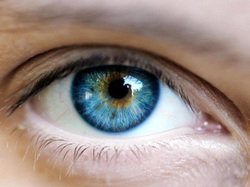 When reflecting upon the claustrophobic nature of our experiences in the caves of Ye Olde Trip To Jerusalem, the first thing that struck us was what we see. The visual aesthetics of a place are often the most common thing that we notice. More recent Western world architecture has become quite well known for focusing on appealing to the eyes and often ignoring the other senses. As such we have become accustomed to using our eyes as our primary sources of architectural appreciation. Ye Olde Trip To Jerusalem provides a far broader experience than simply a visual one. But the sense of sight took a big part in our exploration of the inn. It is the logical place to start.
Ye Olde Trip To Jerusalem is located by Nottingham Castle near Maid Marian Way. It is at the foot of the castle, embedded into the cliff face up on which the
castle sits.
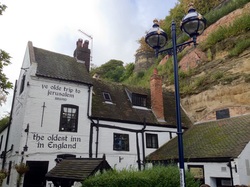 Ye Olde Trip To Jerusalem is the oldest inn in England. Dating back over 800 years, it is filled with history. The inn itself travels back into the rock face that it sits by, consisting of a network of caves. The interior of the building is extremely claustrophobic, with a winding series of caved rooms connected with narrow staircases. The smooth walls do however soften the experience, but the low ceilings serve as a real inconvenience for navigation purposes.
Inside the pub, it's extremely dim, but the artificial light illuminates the walls, creating a subtle shadows and ambience. The warm, amber lighting allows the inn to feel reminiscent of how it might have felt when it was first opened.
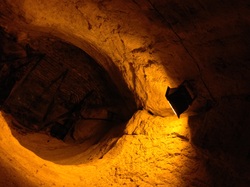 This is because the inn would originally have been lit using the light from flames. The link back to history can create the idea of being taken out of the modern world and what is familiar, placing you in a tight, claustrophobic, unfamiliar place.
The tight space and low ceilings add to the acoustics of the caves. Sound behaves differently there, shifting the atmosphere. It is interesting how atmosphere can change with space and sound, this is something which we must investigate.
|

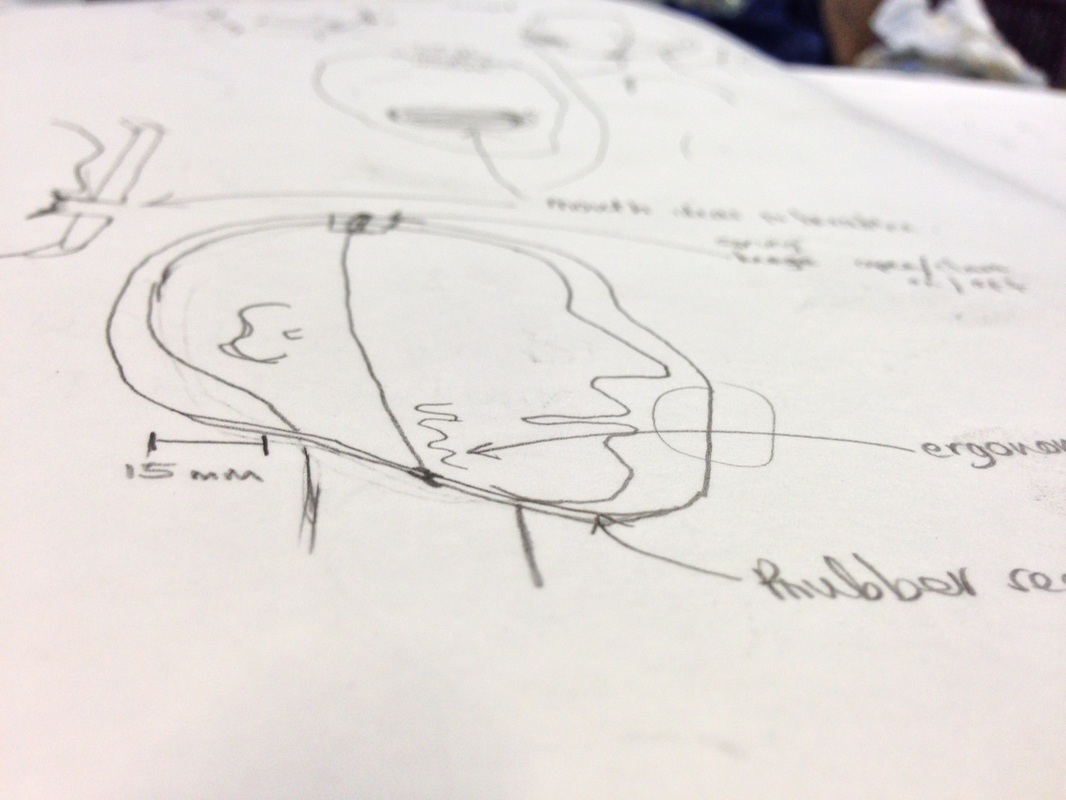
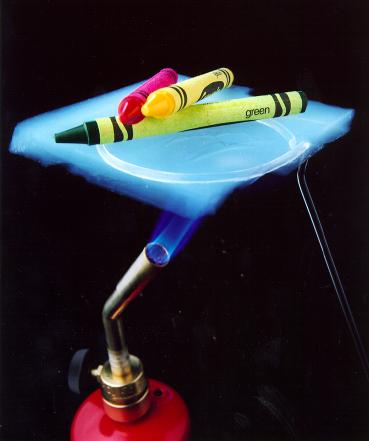


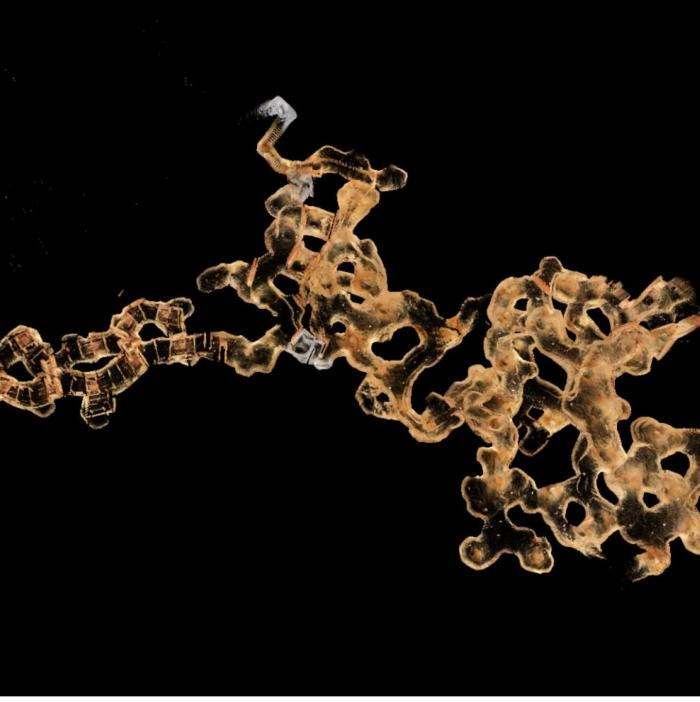
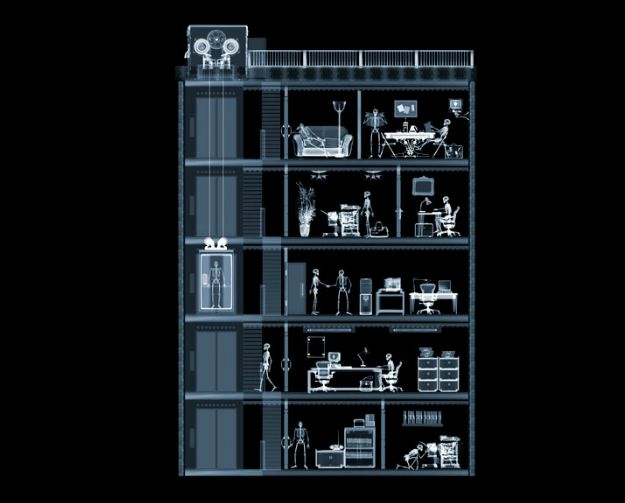



 RSS Feed
RSS Feed